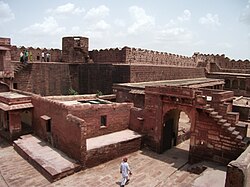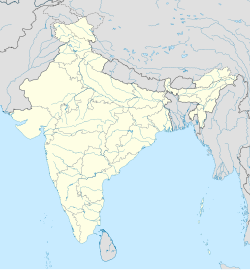Pokhran (official spelling Pokaran; Hindi: पोकरण) is a town and a municipality[1] located 112 km east of Jaisalmer city in the Jaisalmer district of the Indian state of Rajasthan. It is situated in the Thar Desert region. Surrounded by rocks, sand and five salt ranges, the word "Pokaran" (पोकरण) means "place surrounded by five salt-ranges" in Rajasthani. The site for India's first and second underground nuclear weapon test is near Pokhran.
Pokhran | |
|---|---|
Town | |
 Pokhran Fort in Rajasthan, India | |
| Coordinates: 26°55′N 71°55′E / 26.92°N 71.92°E | |
| State | |
| State | Rajasthan |
| District | Jaisalmer |
| Government | |
| Elevation | 233 m (764 ft) |
| Population (2011) | |
• Total | 28,457 |
| Languages | |
| • Official | Hindi, Rajasthani |
| Time zone | UTC+5:30 (IST) |
Geography
editPokhran is located 112 km east of Jaisalmer city, 172 km northwest of Jodhpur and 225 km south of Bikaner by road. It lies on Jaisalmer to Jodhpur railway line. It is situated at 27°05′42″N 71°45′11″E / 27.095°N 71.753°E and has an average elevation of 233 metres (764 feet).
It has arid climate as it lies in the Thar Desert and receives a little rain in the monsoon months July to September. Pokhran has extreme climate. It has extremely hot and dry summers from April to June though monsoon months are also very hot. The temperature in summer can reach 46°C during the day. The night temperature in summer is more than 30°C, Pokhran has very cold winters with temperature dropping to 1°C.[2]
There is nothing much to see in Pokhran. Tourists may find winter pleasant during the day but they are not allowed near the nuclear test site.
History
editFort Pokhran
editFort Pokhran, the 14th century citadel also known as "Balagarh", stands amidst the Thar Desert. This monument is the premier fort of the chief of the Champawats, one of the clan of Rathores of the state of Marwar-Jodhpur. Fort Pokhran is open for visitors and is being currently run as heritage hotel by the royal family of Pokhran.
Sati Mata Memorial
editOn the outskirts of the town, the Satiyo Deval Sati Mata Memorial, a royal cenotaph, is freely accessible.
Former rulers
edit- Seat of Chief of the Champawats, a sub-clan of Rathores of the state of Marwar-Jodhpur.
- Bhawani Singh of Pokhran (b. 1911) was the last jagirdar of Pokhran before Indian independence. He was Sessions Judge and was elected to the 1st Lok Sabha, the Lower house of Indian parliament from Barmer-Jalore constituency, after getting elected as an Independent candidate in the 1952 Indian general election.[3][4]
Demographics
editAccording to 2011 Indian census,[5] Pokhran had a population of 28,457 within Pokaran Municipal Board territory. Males constitute 55% of the population and females 45%. Pokhran has an average literacy rate of 56%, lower than the national average of 74.0%: male literacy is 68%, and female literacy is 41%. In Pokhran, 19% of the population is under 6 years of age.
Pokhran Test Range
edit| Pokhran Test Range (PTR) | |
|---|---|
| Near Jaisalmer in India | |
| Coordinates | 27°05′42″N 71°45′11″E / 27.095°N 71.753°E |
| Type | Nuclear test site |
| Site information | |
| Operator | Indian Army |
| Status | Active |
| Site history | |
| In use | 1970–present |
| Test information | |
| Subcritical tests | N/A |
| Nuclear tests | 6 |
The Pokhran Test Range (PTR) is a key component of India's nuclear programme which is located outside the Pokaran Municipal Board jurisdiction and is controlled by the Indian Army. The army base is located 45 km north-west of Pokhran town and 4 km north of Khetolai village.[6]
The army base was built by the Indian Army Corps of Engineers and is under the control of Indian Army. It was built sometime before May 1974, when, following authorization given to the Bhabha Atomic Research Centre by then-Prime Minister Indira Gandhi, it hosted the detonation of India's first nuclear device.
Nuclear testings
editThe Ministry of External Affairs designated the test "Pokhran-I", but it is also known as "Smiling Buddha". It was India's first successful nuclear bomb test on 18 May 1974.[7][8] The bomb was detonated on the army base Pokhran Test Range (PTR), in Rajasthan, by the Indian Army under the supervision of several key Indian generals.
On 11 and 13 May 1998, twenty-four years after Pokhran-I, the Indian Defence Research and Development Organisation (DRDO) and Atomic Energy Commission (AEC) conducted five further nuclear tests, dubbed "Pokhran-II", at the Pokhran range. Four AEC devices and, under the codename Shakti, a thermonuclear device were tested.
Since 2014, the elevated and frequent cancer deaths at the Khetolai has been attributed to the nuclear testing at the Pokhran Test Range.
See also
editReferences
edit- ^ "Sectoral Portal".
- ^ https://www.nativeplanet.com/pokhran/weather/ [bare URL]
- ^ Soszynski, Henry. "Pokhran (thikana) Genealogy". Archived from the original on 22 December 2015. Retrieved 24 June 2014.
- ^ "Members Bioprofile: First Lok Sabha". Lok Sabha website. Archived from the original on 24 June 2014. Retrieved 24 June 2014.
- ^ "Census of India 2001: Data from the 2001 Census, including cities, villages and towns (Provisional)". Census Commission of India. Archived from the original on 16 June 2004. Retrieved 1 November 2008.
- ^ Forty years after Pokhran nuclear tests, villagers complain of frequent cancer deaths, Scroll.in, 18 May 2014
- ^ FIles. "1974 Nuclear files". Nuclear Age Peace Foundation. Nuclear files archives. Archived from the original on 14 May 2013. Retrieved 14 January 2013.
- ^ "Smiling Buddha, 1974". India's Nuclear Weapons Program. Nuclear Weapon Archive.

